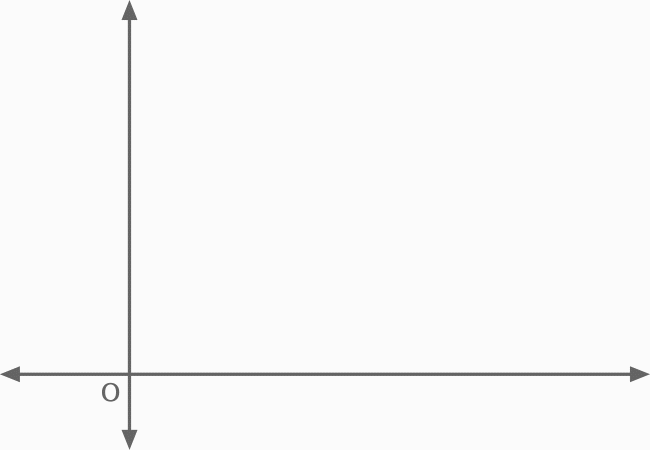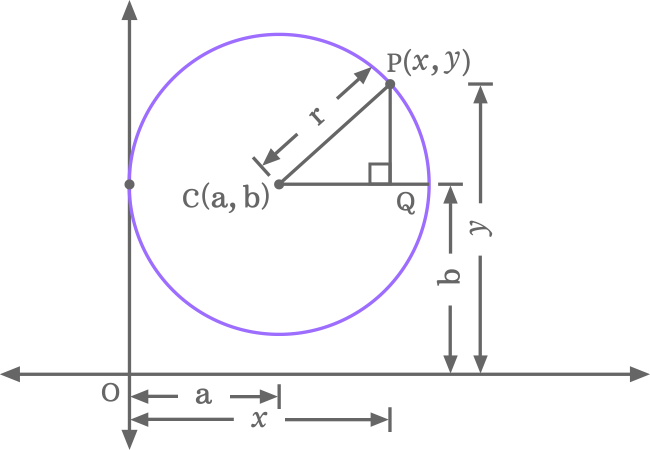The equation of a circle when the circle touches the y-axis is written in one of the following two forms in mathematics.
$(1).\,\,\,$ $(x-a)^2+(y-b)^2 \,=\, a^2$
$(2).\,\,\,$ $(x-h)^2+(y-k)^2 \,=\, h^2$
Let us learn the geometric procedure to know how to prove the equation of a circle in mathematical form when the circle is touching the $y$-axis in two dimensional space.
A right triangle (or right angled triangle) should has to construct geometrically inside a circle when the circle touches the $y$-axis at a particular point in a quadrant of the two dimensional Cartesian coordinate system for deriving the equation of circle.

In $\Delta PCQ$, $\overline{PQ}$, $\overline{CQ}$ and $\overline{CP}$ are the opposite side, adjacent side and hypotenuse, and the lengths of them are written as $PQ$, $CQ$ and $CP$ respectively in mathematics.

Now, let us find the length of every side of the right angled triangle in algebraic form.
In this right triangle, the length of each side is known to us. So, the relation between three sides can be written in mathematical form by using the Pythagorean Theorem.

${CP}^2$ $\,=\,$ ${CQ}^2+{PQ}^2$
Now, replace the length of each side in the above equation.
$r^2$ $\,=\,$ $(x \,-\, a)^2$ $+$ $(y \,-\, b)^2$
$\implies$ $(x-a)^2$ $+$ $(y-b)^2$ $\,=\,$ $r^2$
Here, $OC \,=\, r \,=\, a$.
$\,\,\,\therefore\,\,\,\,\,\,$ $(x-a)^2$ $+$ $(y-r)^2$ $\,=\,$ $r^2$
This equation can also be written as follows.
$\,\,\,\therefore\,\,\,\,\,\,$ $(x-a)^2$ $+$ $(y-b)^2$ $\,=\,$ $a^2$
The above two equations express the equation of a circle when the circle is touching the vertical $y$-axis at a point.
Use the square of difference formula to expand the square of difference of the terms.
$\implies$ $x^2$ $+$ $a^2$ $-$ $2ax$ $+$ $y^2$ $+$ $b^2$ $–$ $2by$ $\,=\,$ $a^2$
$\implies$ $x^2$ $+$ $y^2$ $-$ $2ax$ $–$ $2by$ $+$ $a^2$ $+$ $b^2$ $\,=\,$ $a^2$
$\implies$ $x^2$ $+$ $y^2$ $-$ $2ax$ $–$ $2by$ $+$ $b^2$ $+$ $a^2$ $\,=\,$ $a^2$
$\implies$ $x^2$ $+$ $y^2$ $-$ $2ax$ $–$ $2by$ $+$ $b^2$ $+$ $a^2$ $-$ $a^2$ $\,=\,$ $0$
$\implies$ $x^2$ $+$ $y^2$ $-$ $2ax$ $–$ $2by$ $+$ $b^2$ $+$ $\cancel{a^2}$ $-$ $\cancel{a^2}$ $\,=\,$ $0$
$\,\,\,\therefore\,\,\,\,\,\,$ $x^2$ $+$ $y^2$ $-$ $2ax$ $–$ $2by$ $+$ $b^2$ $\,=\,$ $0$
This equation represents the circle’s equation when the circle touches the $y$-axis at a point and it can also be written in the following form by replacing the $a$ with $r$.
$\,\,\,\therefore\,\,\,\,\,\,$ $x^2$ $+$ $y^2$ $-$ $2rx$ $–$ $2by$ $+$ $b^2$ $\,=\,$ $0$
The equation of a circle when the circle is touching the $y$-axis is also written in the following two forms if the centre (or center) is considered as $C (h, k)$.
$(x-h)^2+(y-k)^2 \,=\, h^2$
$x^2$ $+$ $y^2$ $-$ $2hx$ $–$ $2ky$ $+$ $k^2$ $\,=\,$ $0$
A free math education service for students to learn every math concept easily, for teachers to teach mathematics understandably and for mathematicians to share their maths researching projects.
Copyright © 2012 - 2025 Math Doubts, All Rights Reserved